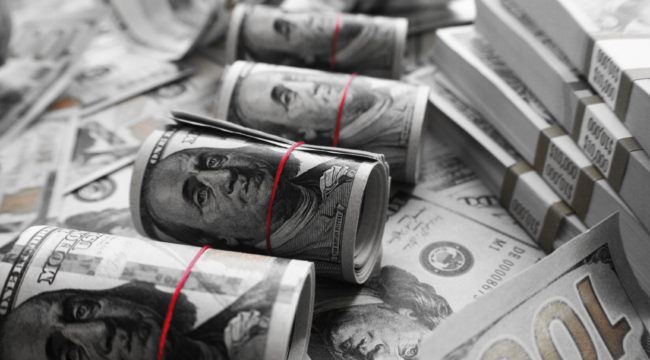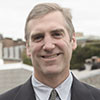The Great Paradox of Today’s Market
“Can a tightening be considered effective if financial conditions… ease?”
Claudio Borio, head of the Bank for International Settlements’ Monetary and Economic department, here poses a thumping question.
The Federal Reserve bumped interest rates 0.25% last week — the fifth rate hike since 2015.
It has also begun reducing its Himalayan balance sheet that has lifted markets to Himalayan heights.
And yet — and yet — we are reliably informed that U.S. financial conditions are presently the easiest in decades.
Both the St. Louis and Chicago Federal Reserve Banks confirm that financial conditions are the easiest since January 1994.
But how can financial conditions loosen… when money supposedly tightens?
Consider the paradox…
Assume… as a reasonable fellow would… that tightening credit is poor for stocks.
Yet the Dow marches double-time toward 25,000. The S&P assaults records by the day. The Nasdaq is up over 25% this year alone.
Meantime, the Bank of England has determined that the global risk-free rate — the theoretical rate of return of an investment with zero risk — has plumbed depths unseen since the 1300s.
Tighter money… easier financial conditions.
What does our central bank make of the paradox?
Mona Mahajan, strategist with Allianz, says the paradox has “been puzzling to the Fed.”
Doubtless true.
But what isn’t puzzling to the Fed nowadays?
We begin to suspect one plus one might stump it, the square root of four — or the number of angles in a triangle.
Eight baffling years and trillions of confused dollars after the financial crisis… the Federal Reserve can’t even work a meager 2% inflation rate.
Its beloved Phillips curve — the supposed tradeoff between unemployment and inflation — has been reduced to a poor joke.
No longer can the chairman of the Federal Reserve bear the title “maestro.”
The outgoing conductor is a preposterous formula who couldn’t reproduce a note of Mozart at the price of her soul.
Even the Fed’s loudest drummers have begun to cough sadly behind their hands at the pitiful spectacle.
But if you wish to know why financial conditions remain so easy, perhaps you should direct your focus overseas…
The Fed tightens, yes.
But there is the European Central Bank to consider, for example…
Last week, ECB President Mario Draghi predicted inflation would remain below target into 2020.
He has pledged to provide stimulus as long as needed.
Read between the lines, if you wish.
Meantime, the ECB has committed — and here “committed” might take on psychiatric coloring — to continue bond purchases through next September at minimum.
In considering our paradox, we must also consider the Bank of Japan…
The Bank of Japan’s own 2% inflation goal remains a distant vision, shimmering in the mists atop Fuji.
A recent Reuters poll of economists indicates the BOJ will keep the monetary taps flowing good and strong until late 2018 — or beyond.
We place our money on “beyond.”
In nuce: many of the world’s leading central banks continue funneling credit.
Former Goldman Sachs managing director Nomi Prins calls it “dark money.”
Nomi says this “dark money” is the financial markets’ biggest secret:
The “dark money” comes from central banks. In essence, central banks “print” money or electronically fabricate money by buying bonds or stocks… Dark money is the No. 1 secret life force of today’s rigged financial markets. It drives whole markets up and down. It’s the reason for today’s financial bubbles.
Nomi has embarked upon a brand-new project to track these “dark money” flows around the world… and into every crevice of the financial system.
By tracking these flows to their final destination, Nomi says everyday investors can profit handsomely — if they know where to look
Why might certain Chinese green energy stocks be so attractive, for example?
“Dark money.”
Why could it be a prime occasion to invest in a specific Japanese telecom?
“Dark money.”
Why might a certain U.S. brokerage firm be worth a look right now?
“Dark money.”
But will the Fed soon be issuing more “dark money” of its own?
Jim Rickards has argued repeatedly that the Fed is “tightening into weakness.”
Jim says this tightening could cause the very recession the Fed is trying to avoid.
Then it’s back to lower rates again… and even looser than today’s financial conditions… which are themselves the easiest since January 1994.
Macroeconomic analyst Peter Schiff:
The hikes only sow the seeds of their own reversal because eventually, the Fed has to reverse course and start lowering rates… If financial conditions are this loose now when the Fed is tightening, imagine how much looser they are going to get when the Fed is easing…
We cannot imagine, Mr. Schiff.
Even our imagination has its limits…
Below, Nomi shows you why the adage, “It takes money to make money,” needs to be updated to “It takes dark money to make money.” Read on.
Regards,
Brian Maher
Managing editor, The Daily Reckoning



Comments: